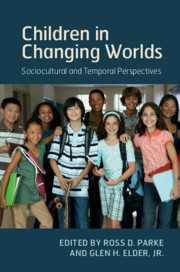Book contents
- Children in Changing Worlds
- Children in Changing Worlds
- Copyright page
- Contents
- List of Figures
- Contributor Biographies
- Preface
- Part I Theoretical and Methodological Approaches: A Cross-Disciplinary Challenge
- Part II Historical and Life Course Transitions: Economic and Demographic Change
- 2 When Societal Events Occur in Lives: Developmental Linkages and Turning Points
- 3 Entering Adulthood in the Great Recession: A Tale of Three Countries
- 4 Developmental Risk and Resilience in the Context of Devastation and Forced Migration
- 5 Children’s Migratory Paths Between Cultures: The Effects of Migration Experiences on the Adjustment of Children and Families
- 6 Education in Historical and Cultural Perspective
- Part III Social, Legal, and Technological Change: Impact on Children
- Part IV Views of the Interdisciplinary Dialogue: From Developmental Science and Sociology
- Author Index
- Subject Index
- References
4 - Developmental Risk and Resilience in the Context of Devastation and Forced Migration
from Part II - Historical and Life Course Transitions: Economic and Demographic Change
Published online by Cambridge University Press: 18 July 2019
- Children in Changing Worlds
- Children in Changing Worlds
- Copyright page
- Contents
- List of Figures
- Contributor Biographies
- Preface
- Part I Theoretical and Methodological Approaches: A Cross-Disciplinary Challenge
- Part II Historical and Life Course Transitions: Economic and Demographic Change
- 2 When Societal Events Occur in Lives: Developmental Linkages and Turning Points
- 3 Entering Adulthood in the Great Recession: A Tale of Three Countries
- 4 Developmental Risk and Resilience in the Context of Devastation and Forced Migration
- 5 Children’s Migratory Paths Between Cultures: The Effects of Migration Experiences on the Adjustment of Children and Families
- 6 Education in Historical and Cultural Perspective
- Part III Social, Legal, and Technological Change: Impact on Children
- Part IV Views of the Interdisciplinary Dialogue: From Developmental Science and Sociology
- Author Index
- Subject Index
- References
Summary
Disaster, conflict, and forced migration are rising around the world, generating alarm about the long-term effects of trauma and devastation on child development. This chapter reviews theory and findings on risks, challenges, and resilience of children confronted with trauma and displacement in the context of conflict, terror, and disaster.
Models of resilience are described, with a focus on contemporary perspectives grounded in developmental systems theory. Resilience is defined as the capacity of a system to adapt successfully to challenges that threaten its functioning, survival, or future development. Evidence on the threats, adaptation, and protective processes that shape adjustment and the future development of young people displaced by life-threatening community-level crises are highlighted. Ethical, methodological, and practical issues and controversies in the research are discussed. The conclusion summarizes research progress, implications for intervention, and future directions of this body of research.
- Type
- Chapter
- Information
- Children in Changing WorldsSociocultural and Temporal Perspectives, pp. 84 - 111Publisher: Cambridge University PressPrint publication year: 2019
References
- 16
- Cited by

